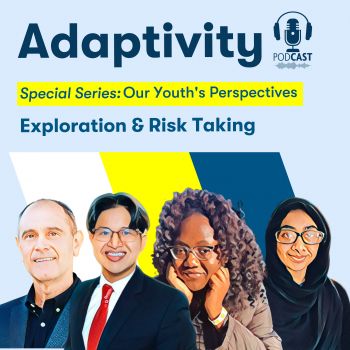Ron Dahl This COVID-19 pandemic reveals a striking paradox for adolescents: On the one hand, they’re the least likely to be infected or to become seriously ill. On the other hand, the drastic social changes to combat the disease are having a profound impact on them.
Theo (age 15) I can’t see friends, and I have to stay inside, and doing a lot of online work instead of paperwork, and I’m not meeting with teachers. It can feel a little lonely, and it’s hard, but I know it needs to be done so that we can flatten the curve.
Ron Dahl They’re dealing with school closures and the inability to participate in sports, games, social events, and dating.
Amelia (age 12) Getting excitement from just like drama at my school, even that I’m missing. Just the excitement. And without that it feels like so…blah.
Ron Dahl Adolescents are not just missing their friends. They’re also missing the in-person peer group experiences—the complex social dynamics that can make middle school and high school environments so stressful and so exciting. Crucially, these settings are also a cornerstone of adaptive social learning.
I’m Ron Dahl, and this is Adaptivity, where we explore the science of adolescence, untangling misconceptions about the years between childhood and adulthood. We explore new insights into the rapid cognitive, emotional, and social changes that happen during these years. And how the developing adolescent brain is primed to promote healthy and adaptive learning.
With the closure of schools and social distancing, almost everything about normal adolescent development has been changed. There’s been a massive increase in the use of technology as a part of distance learning and for creating social connection. Today I’m talking with two experts in adolescent development about how we can support youth during this pandemic, and how their increased engagement with technology in particular is crucial and complicated.
Candice Odgers I’m Candice Odgers, I’m a professor of psychological science at the University California, Irvine. I spend most of my time trying to understand what young people are doing online, how that’s influencing their offline lives, and how that might be linked to their mental health.
Nick Allen And hi, my name’s Nick Allen. I’m a professor of clinical psychology at the University of Oregon, and my main interest there is looking at ways in which digital technology can be used to improve mental health, prevention programs, and mental health services.
Ron Dahl This coronavirus has adapted opportunistically to infect humans not only at a biological level but also by targeting the fundamentally social nature of our species. Our natural human desire to connect, to embrace, to share meals and celebrate in groups must be aggressively countered in order to deal with this virus until we have other treatments and vaccines.
These natural social motivations are amplified in striking ways in adolescence. Adolescents want to connect. They have a natural desire to explore new relationships outside the boundaries of their family, particularly with friends and romantic partners. And so, if technology is one of the only ways to do those positive things—to connect, to create, to contribute—I think these are really important perspectives for how to support young people and not just create conflict around screen-time.
Candice Odgers I read this quote from a colleague of mine that said, you know, I owe Fortnite an apology. You know, it was the way that her 14-year-old son was connecting with his peers.
Henry (age 14) (playing video games) Wait, is that Mateo? I found Mateo, guys. He’s in the corner.
Nick Allen Kids who are already gamers and who play the kinds of games where they communicate, they form teams online and they chat to each other and so forth, they do have an enormous advantage because they have a way to play with their friends. When you’re interacting with people online, you want a balance between sort of more pure interpersonal communication, you know, chatting about what’s going on, how are you doing, and also having goal-directed behaviors that you’re doing together. And gaming provides a fantastic platform for that.
Candice Odgers This is one of those big gender differences. We know that boys game at much higher rates. I think the most recent data had them over two hours on average a day, and, you know, girls were still in the 20-minute range per day. So girls just aren’t kind of drawn to these games the same way. It does provide this playground. There’s not a lot of, I think, deep conversation and social connection happening, although there can be, and there are a number of streamers who are actually using their large followings to provide mental health support right now.
Ron Dahl This need for social connection, and the reliance on digital technology to create those healthy opportunities also bring up social inequities. Many young people in the U.S. don’t have easy access to digital technology. And that digital divide is and that digital divide is largely felt by lower-income and black and historically underrepresented adolescents. This not only affects their academics but also their formative social experiences during a key period of identity development.
Candice Odgers These kinds of shocks can be inequality amplifiers and that certainly was the case in 2008, and seems like it might be the case here. And we know the most tangible kind of example is the educational access. There was a survey done in April and found that kind of 40 percent of adolescents hadn’t even accessed the remote learning. Right. So that’s just not even participated as at all versus any conversation about who benefits. And we know that children in less scaffolding or support are the least likely to benefit from the remote instruction model in its current form. So I think we have big concerns around kind of growing educational inequalities, I think, in terms of the screen time and digital technology space.
Nick Allen One of the great advantages of digital technology is that it increases access. And so if we can design the right digital spaces that deal with mental health, that improve social connection, that increase employability, all these sorts of things, at least in theory they should be able to reduce inequality. But as Candice points out, that’s not always the outcome that we get. After the initial part of this challenge is over, we will have to be especially determined to make sure that those people who really are more likely to experience mental health problems, financial problems, employment and education disruption, that the possibilities of digital technology are really available to them because it is one way of reducing that inequality.
Ron Dahl What are some other things we need to be thinking about to promote healthy versions of tech use in adolescence?
Candice Odgers You know, older adolescents already have their patterns of interaction on social media, on their kind of chat groups, those types of things. So they’ve worked out in many ways what works for them online. So some of this will be just continuing to do some of the things that kind of feel good in terms of eliciting social support or interest and those types of things. I think there’s a group that’s younger adolescents who might be entering into digital spaces a little bit earlier than their parents might want right now. They haven’t had the kind of scaffolding or experience to really develop some healthy practices. And so that younger group in the kind of 9- to 14-year-old range, for many of them, they’re going to be spending more time online than intended and they’re going to need some additional support. So maybe that support is from an older sibling, maybe its parents sitting down and really walking through some of the social media sites that they’re interested in spending more time on. But more care and attention is going to be needed for that age group.
Nick Allen Yes, I totally agree. The younger kids are going to be the ones who are entering into these relationships for the first time and they’ll be learning to manage the online space in a new way. And they’ll also be managing some of those new burdens that come with online interactions: the potential for bullying and ostracism and difficult conversations, and also managing how it affects their daily cycles. You know, so their sleep, because sleep is something that’s also fairly disrupted at the moment for young people because they don’t have some of those clear, you know, regulators of sleep like school times in the way that they normally do. And so that means the use of digital technology is, if you like, permitted to interfere with sleep even more than it may usually do.
Ron Dahl You make an interesting point about the importance of this developmental window—the transition from childhood into adolescence, that often begins by age 10 or 11. This is a really key time to be thinking about supporting young people and their needs when social and emotional learning experiences are shaping identity development in new and formative ways. Nick, you have a lot of clinical expertise dealing with adolescent mental health and well-being. What are you seeing right now?
Nick Allen There’s a much higher level of mental health distress in the community. There’s a number of rapid studies that have been rolled out during the coronavirus period, and it’s clear that people are experiencing a much higher rate of mental health problems than is usual. And furthermore, many of the things that we know as lifestyle factors that are strongly mood supportive, that support people having good positive moods and reducing anxiety, are currently being either inhibited or the structures that support them are being taken away. So particularly we’re talking about things like healthy sleep, about healthy levels of physical activity, healthy levels of social activity, a good balance between work and leisure. You know, all the lifestyle factors that we know from extensive empirical research are really supportive of good mood either being impeded or the scaffolds that sit around those behaviors are being taken away. So it is a time when young people are going to be especially vulnerable to increases in anxiety and depression. The good news is, if you want to put it that way, is that when you have these periods of change, it’s also a period of potential learning. So in other words, people are having to consciously learn to manage aspects of their lifestyle that have become perhaps a bit more habitual in their regular lives. And this creates an awareness of the role of things like sleep, physical activity, social connection, behavioral engagement, you know, with goals, with hobbies, with learning and how they relate to mood.
Ron Dahl As adults we often think about this dichotomy of in-real-life social interactions and technology-based social interactions. But increasingly for young people, they don’t make those distinctions. They are just interacting with their friends, peers, new people that they’re meeting. And so this idea that it’s the same principles that you would use in terms of how young people are interacting and navigating as opposed to judging it as technology or screens, seems to be an important part of how to approach thinking about these issues.
Nick Allen The essential processes that are occurring online are not fundamentally different to those that occur offline. So in other words, interacting offline can be good or bad depending on what you’re doing, and I think if the same is true online. If they’re experiencing higher levels of mental health problems and mental health symptoms because of the stresses and the burdens of risk of infection and isolation, then there are some interpersonal processes which can occur online, which are actually potentially difficult for young people to go through, and one in particular I would highlight is something that psychologists call ‘co-rumination.’ So that is where two young people who are feeling depressed or anxious talk to each other and they focus on their experiences of anxiety and depression, and they develop a pattern of escalation.
Ron Dahl So that brings up another dimension of these complex issues around negative affect: negative emotion. Most of us are dealing with increased negative emotion and stresses and challenges and anxieties. And, of course, the young people are as well, but the interaction between negative emotions tends to lead to a lot of conflict right during a period of development when parent-child conflict often goes up as adolescence begins. And so how can adults interacting with young people and trying to provide support do a better job of navigating these increased negative emotions in these interpersonal situations?
Candice Odgers When we looked at reports coming out of families of the things that they often argue about or that cause conflict in families, it always relates around screens. And not just screens, but how much time kids are spending online. Parents not liking it, kids wanting more. Now, if you back out a little bit, we know from decades of research within families that family conflict is one of the most toxic things for adolescent mental health. And screens, actually, the evidence there is mixed. The effects seem to be quite small. So what could be happening is all of this conflict that’s happening around screens is actually more harmful than the screen time itself. So one way to kind of flip that script around screen time is to take a bit of a breath, but then to ask, you know, even ask ourselves, ask youth to ask themselves, “When I’m going online, am I doing it to connect? Am I doing it to create? Am I doing it to contribute?” Right. And if you’re doing it for one of those three reasons it often leads to kind of a positive approach to interacting on screens.
Ron Dahl What I would like to ask each of you is what are your general thoughts about how we as adults, whether that’s as parents, teachers—how can we support healthy adolescent development during this COVID-19 pandemic?
Candice Odgers So I think the first thing that we can do as adults is to take a deep breath. We know that screen time is going to increase and that’s something that adults don’t tend to like with young people. But young people are going to have to be on their screens for education. It’s often the only way they can connect with peers, with other family members. And the good news about that is that much of the research today actually shows that additional time on screens doesn’t have a lot of deleterious effects. So there’s not quite the evidence there supporting the fact that all the screen time is bad. Now, we want to make sure that we’re supporting them in using it in healthy ways and we’re not spending all of our time on screens.
Nick Allen Yeah, I agree and of course, in many ways, you could make a case, I think that adolescents are socially amongst the most disadvantaged groups by shelter at home and self-quarantine policies because you know, I think with younger kids, they often really enjoy being at home with the family and they’re probably enjoying have their parents around, but there’s a critical developmental drive in adolescence to connect with peers and, you know, engage in those sorts of peer experiences where they’re learning so much of what they need to learn. And this is massively disrupted right now for them. And so digital technology is key as a key opportunity to maintain those peer relationships, and I think many young people would be feeling even more isolated and more feeling that burden of the mental health burden of isolation if they didn’t have digital technology to do that.
Candice Odgers We’re facing a wicked problem, right, that’s throwing uncertainty and new challenges at families every day. And sometimes as adults, we underestimate our kids’ problem-solving ability, you know, kind of big or small. But the thing about this pandemic is that there are a series of uncertainties and problems that are being thrown at us and giving us lots of opportunity to kind of work as a team and figure out what might work and provide adolescents with the ability to contribute. You know, I’ll pull back from the Great Depression. So Glen Elder did a lot of work in terms of the age at which kids were when the depression hit and found actually that older adolescents tended to do better in terms of long-term outcomes, in part because they could go to work and help the family contribute—they could be part of the solution. So one question to ask might be, how can we engage children, younger and older as being part of the solution to how we need to adapt—sometimes hour by hour—to what’s thrown at us?
Ron Dahl I think sometimes when people are focusing on the magnitude of the challenges for this generation, it’s almost as if they’re saying they’re damaged in a way that I think can be counterproductive. And so it makes it even more important to think about how to promote positive development. How much more important is it for them to find ways to be creative and contribute and connect? How can certain kinds of experiences create more resilience? I think that we can recognize that this has been an unprecedented set of changes and challenges that maybe no other generation has had quite the same way. And to still hold this opportunity frame to create these positive developmental and learning experiences to try to offset them.
Candice Odgers So if you look across a number of metrics, this generation looks much better than ours, right? In terms of educational graduation rates, in terms of rates of violence and substance use, teen pregnancy, really kind of big problems that previous generations have struggled from. Kids today, young people today, look better than prior generations on this. Now, we do have this increasing uptick of internalizing problems that are coming up. But in the face of all of these kinds of structural insults and challenges, this generation has really risen, you know, on a number of costly, powerful indicators, and they deserve credit for that and respect for that, and, are, you know, in many cases, taking up leadership positions and working to try and create the world that they want. You know, that requires kind of resources, that requires supporting them, that requires adults kind of changing, flipping the script in terms of how we think about it, how we describe this generation.
Ron Dahl The COVID pandemic is a reminder that we can’t predict what global challenges the next generation will face in their lifetimes. Checking in with adolescents about how screen time is making them feel, engaging them in finding solutions—these are especially important right now as we deal with an unprecedented level of uncertainty. As we’ve discussed, adolescence is an essential developmental period for learning who we are, where we fit in, and how we matter through our interactions and relationships with others. Technology is now one of the only reliable avenues for these essential learning experiences. We need to utilize our best science to address inequity and support all adolescents. We must invest in promoting healthy development and resilience to not only help them thrive through this pandemic, but also give them the skills, tools, and motivation to meet the global challenges we face.
I’m Ron Dahl, thanks for joining us on Adaptivity.
If you’d like to learn more about the science of adolescence, visit us at adaptivitypodcast.org. Share your thoughts by emailing us at adaptivity@developingadolescent.org or using the hashtag #adaptivitypod.
Our podcast is produced at UC Berkeley by the Center for the Developing Adolescent. Our Senior Producer is Shuka Kalantari. Our producer is Meghan Lynch Forder. Our engineer is Katie McMurran.

_350_350_80_c1.jpg)
_350_350_80_c1.jpg)









